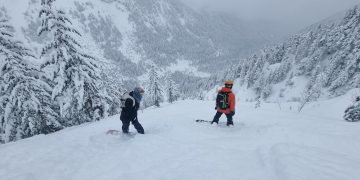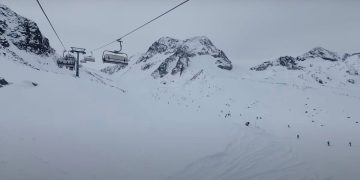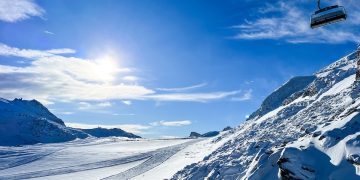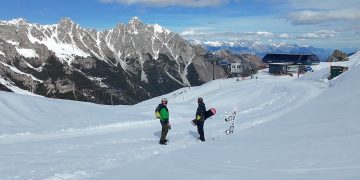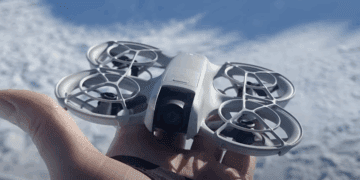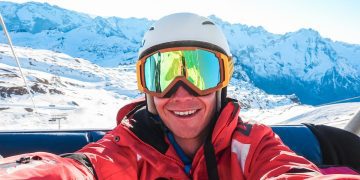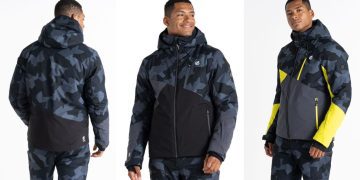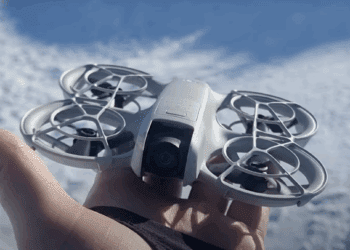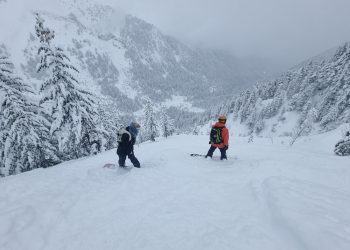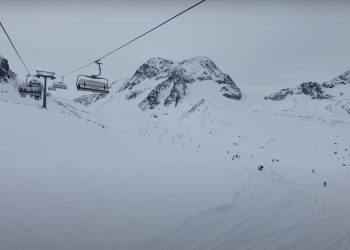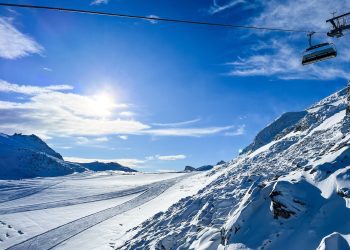Ski jackets are an indispensable piece of kit for any skier or snowboarder. They keep you dry, warm, and comfortable as you carve those turns – and more importantly, while you’re sitting on the chairlift back up.
And of course, a good ski jacket is also an essential piece of kit for your apres ski style too. Basically, you need to be comfortable, have the right technical features and look good.
However, the process of choosing the right ski jacket can initially seem overwhelming. Thanks to the plethora of styles, brands, and prices available on the market, you can quickly start wondering exactly how much you need to spend, and feel like skiing and snowboarding are seen as expensive hobbies for a reason.
OK – we’ve got your back here.
In this guide (which does feature a few affiliate links), we take a look at exactly what you need and try and help to make sense of the huge array of ski jacket options out there.
Where Will You Be Skiing or Snowboarding?
This is the first and perhaps the most crucial question as the terrain will significantly influence your jacket selection. How you are riding and where will likely influence your choice.
Ski Resorts
On groomed ski resort pistes you are never too far from shelter, and if worst comes to worst, you can head back to the base. Of course, weather conditions can still be hugely changeable, and how you ride in a ski resort will vary from person to person.
In any case, a medium-insulated jacket combined with good base layers allows for flexibility and variety of wear.
Off-Piste and Backcountry
Heading into the backcountry or off-piste pursuits demands more from you and your jacket – riding powder all day is hard work. Shelter might be harder to come by, you could get stuck in a white out, or lost in a forest. It happens.
Opt for a technical shell or a high-insulation jacket with additional windproofing and breathability that provides robust protection against harsh weather.
Cross Country
Ski jackets for cross-country skiing need to be lightweight and highly breathable due to the aerobic nature of this sport. Cross country skiing is usually a specialist skill in itself, but more people than ever are discovering the joys of ski touring, split boarding and cross country skiing.
Softshell jackets are an excellent choice in this case, with the options for layers.
What’s the Difference Between Shell and Insulated Jackets?
In general, most standard jackets that you see marked as ‘ski jackets’ tend to be insulated jackets. This usually means that they offer something like 5k to 10k waterproofing and breathability, as standard, up to anything around 20k. The higher the number, the more waterproof and windproof they are.
Shell jackets are lightweight, offer high levels of wind and water resistance, and are highly breathable. They function as protective coverings, allowing for the layering underneath depending on the intensity of cold and personal preference. Many shell jackets offer premium materials such as merino wool linings, or additional waterproofing.
They also tend to be slightly more expensive due to their technical nature.
Insulated jackets, on the other hand, come with built-in insulation layers, typically down or synthetic, for providing warmth. This is usually what you get when you buy a ski or snowboard jacket off the peg in a sports wear store or online. They tend to be very warm and designed for layering underneath, as you can get very hot after a day on the mountain.
However, both types of jacket will feature elements such as air vents to improve air flow when things get a bit damp.
For most casual skiers and snowboarders, you’ll probably just need a standard insulated ski jacket.
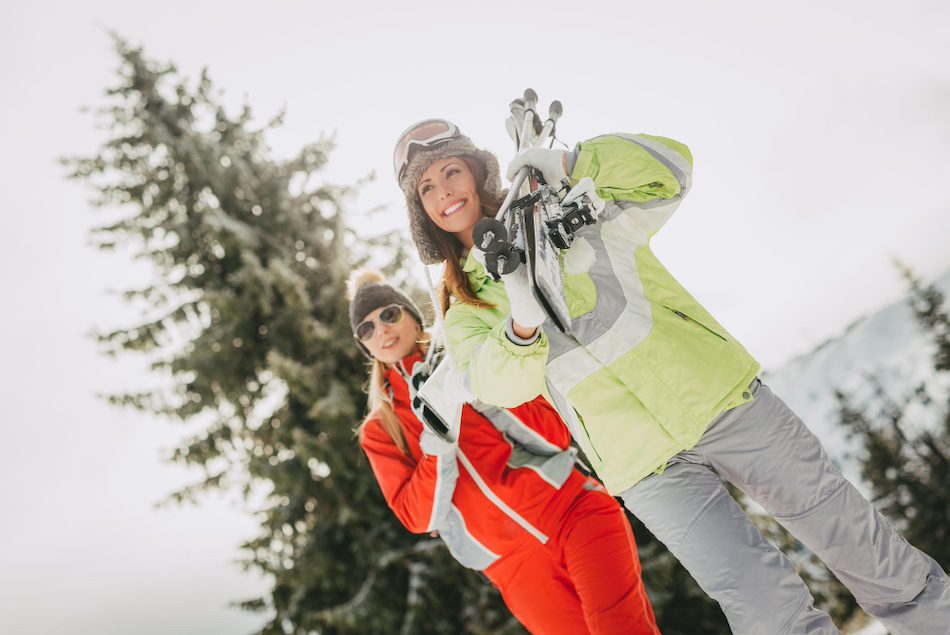
What Are the Important Features of a Ski Jacket?
When you’re buying your ski jacket, there are numerous features that you need to pay attention to. Most generally, these will include:
- Hood: Preferably, it should fit over a helmet and be adjustable.
- Pockets: Look for ample storage options, including a dedicated ski pass pocket.
- Powder Skirt: A built-in, waist-cinching feature to stop snow from entering if you fall.
- Pit Zips: Vents under the arms for temperature regulation.
- Sealed Seams and Waterproof Zippers: This enhances the waterproof characteristics of the jacket.
Many brands of ski jacket will also add in elements such as Gore Tex or other forms of Teflon waterproofing (such as EcoLite or DryRide). More on this below.
Breathability and Waterproofing
Breathability is crucial as it allows moisture from sweat to escape. This capacity is usually indicated by the jacket’s breathability rating in grams.
Waterproofing keeps you dry by preventing moisture from snow or rain from penetrating the jacket. Most jackets have a waterproof rating measured in millimeters. Basically, its how much water the fabric can withstand before it starts to leak and seep water through to the wearer.
The rating normally starts at 5000 (or 5k) as the lowest rating.
10,000 – 20,000 (or 10k to 20k) will be the sweet spot for most.
Over 20,000 (20k) to around 40,000 (40k) will be more ideally suited for adventure skiers and snowboarders heading out into Alaska or the Himalayas.
A 5k waterproof jacket will be fine in crisp and cold conditions with minimal rain or snowfall. You’ll probably need a few layers too.
10k will be about right for most people, with 20k suited to those in colder and harsher conditions.
Budget vs Premium Ski Jackets
When it comes to your choice of ski jacket, the price and brand might be a factor. But, not everyone needs top spec, top branded kit. Obviously this is a personal decision, and also might be influenced by things such as where you’re going skiing or snowboarding, how often you go, who you go with and your own budget.
Lets put it simply.
There are some excellent cheap ski jackets out there. You don’t need to spend upwards of £200 to get a very good quality and high performance ski or snowboard jacket.
Budget brands such as Dope Snow, Dare2B, 4F and Decathlon/Wed’ze all offer top spec kit for seriously low prices.
But then… If you want the best spec kit, built to last and look cool on the mountain too, you’ll be looking for the more premium snowsports brands.
Lets go through the most common questions for snowboard and ski jacket buyers.
Do You Need Gore Tex?
For about 75% of skiers and snowboarders, no.
Most ski jackets are about as waterproof as you’ll ever need them to be without Gore-Tex. And, to add to this, many brands use their own version of Gore-Tex, which is basically a Teflon coating. Brands such as Burton, Picture Organic and Patagonia all have their own waterproofing that doesn’t use the Gore-Tex branding but is just as good,
In short: Gore-Tex is a premium waterproof and breathable fabric. It is highly effective but can be expensive. Consider whether your skiing activities and budget justify this investment.
Check out our pick of budget ski jackets, some with Gore-Tex!
Does Branding Matter?
While some brands equate to high-quality workmanship and materials, don’t be swayed merely by the logo. As mentioned above, many lesser-known brands offer excellent products at a fraction of the price.
But this is a personal choice, and label conscious skiers and snowboarders might prefer to spend the additional money on a branded ski jacket. Arc’Teryx, Patagonia, Burton and Ortovox might offer premium styling and top notch durability.
But increasingly, brands like Columbia, Montec and Salomon offer top quality ski jackets at very reasonable prices.
How Much Should You Spend on a Ski Jacket?
Obviously, this depends on your budget and skiing frequency. High-end jackets can cost anything upwards of £200 ($250) to, well… the sky is the limit. While budget options can be found for under £100/$120.
The mean price for a decent ski jacket will be around the £200-300/$250-375 price range. For this you’ll get a premium brand with all the essential features you’d expect, and it should last you many seasons to come too.
Investing more in your quality ski jacket generally means better durability and performance. But gauge this against your usage and affordability. If you’re gonna be hitting the mountain for weeks at a time, sure, splash out on a more expensive jacket that you’ll be happy to be seen in.
Only go skiing or snowboarding for a week every season? Your Decathlon/Wed’ze jacket for under £100 will do just fine!
Fit and Sizing Guide
Sizing wise, it’s usually best to err on the side of slighly larger than you would otherwise go for. You want to have some space for movement, as skiing and snowboarding are both very energetic sports – even if you’re just cruising.
Generally speaking, choose a jacket that allows ample room for layering but is not too baggy that it lets cold air seep in. If the jacket feels too tight, it ain’t right.
Also, your snow skirt should help to keep most of the unnecessary cold air out.
Of course, size wise, it will depend on your own height and waist. Check the brands sizing guides if you’re buying online, or try a few different brands on if you’re shopping on the high street.
Five of the Best Ski Jackets for Men and Women
So we’ve picked out our picks of the best ski jackets for guys and gals. We’ve tried to go for an even spread of budget, mid-range and premium here. All of these are standard issue insulated ski jackets.
Mens Ski Jackets
1. Patagonia Powder Town: Stylish, eco-friendly and feature packed. From £315 on Blue Tomato
2. 4F Mens ski jacket: Top quality budget ski wear from Poland. From £97 on Simply Hike.
3. The North Face Sidecut Gore Tex jacket: Maximum protection and styling at North Face £346
4. Coal Traverse Insulated ski jacket. Cool styling and maximum features, From £155 at Blue Tomato.
5. Burton Covert 2L snowboarding jacket. Excellent piece of kit from the snowboard masters. From £250 at Burton UK.
Womens ski jackets
1. The North Face Inclination ski jacket. Top quality ski jacket at North face from £270.
2. Columbia Ava Alpine ski jacket. Quality ski gear at budget prices from Columbia. From £119 on Amazon.
3. Burton Powline Gore Tex jacket. Maximum protection, maximum style, From £280 on Burton UK.
4. Picture Organic Seakrest ski jacket. Eco friendly style and protection from Picture. From £165 on Blue Tomato.
5. Patagonia Storm Shift. Gore Tex protection in a stylish premium ski jacket. From £315 at Blue Tomato.
